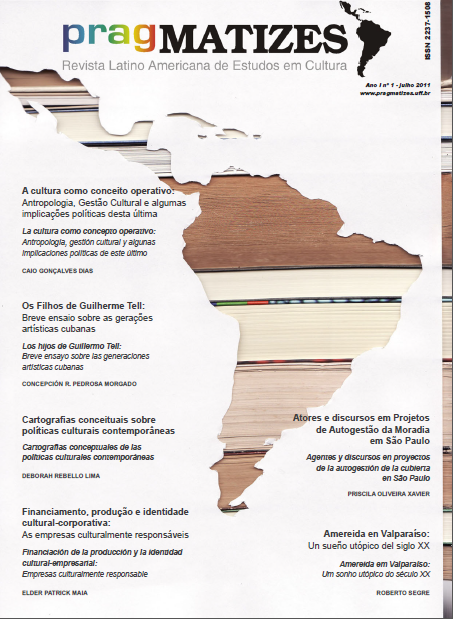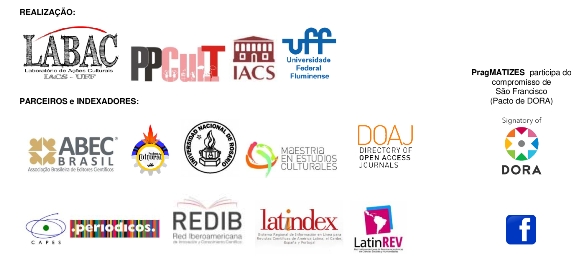Amereida in Valparaiso: an utopian dream of XXth Century
DOI:
https://doi.org/10.22409/pragmatizes.v0i1.10335Abstract
In 1952 came a radical change in architecture teaching at Valparaíso Pontificia
Universidad Católica: the Chilean architect Alberto Cruz Covarrubias and the
Argentine writer Godofredo Iommi introduced that revolution. The new starting
point would encompass the poetic significance of architecture as an expression
of the designer’s singular talent, as well as involving students and teachers within
Latin-American reality. The architectural design begins with a collective poetic act
— called “phalène” —, which identifies the work into a dynamic and changing
process, without defining forms and spaces a priori. In 1970, it was begun the
complex of dwellings and public buildings of “Ciudad Abierta Amereida”,
embodying the social utopia and constructive techniques of the teaching staff of
the school, which is kept until today. In a site located thirty kilometers from Viña
del Mar, in Ritoque, noticeable by its hills and dunes overlooking the Pacific
Ocean, “agoras” for outdoor social activities were randomly constructed, some
buildings for cultural life — a music room — an amphitheater, a cemetery and the
teachers' houses, built by themselves with the help of the students. Its configuration
reflects the influence of Surrealism and the art movements of the sixties.
Latin-American culture is taken through its Latin cultural heritage, the main
component of the regional history: hence, the relationship with Virgil and the epic
poem Aeneid as a justification for the name Amereida given to the "Open City"
complex. This utopian experiment of the second half of the twentieth century is
an important contribution representing an alternative approach for questioning
aesthetic movements already present in Latin-American architecture.
Downloads
References
ALEXANDER, Christopher; HIRSHEN, Sanford;
ISHIKAWA Sara; COFFIN Christie; ANGEL, Shlomo;
Houses Generated by Patterns. Berkeley: Center for
Environmental Structure, 1969.
BACHELARD, Gastón. La Poética del Espacio. México
DF: Fondo de Cultura Económica, 1974.
BENÉVOLO, Leonardo. Historia de la Arquitectura
Moderna.II tomos, Madrid: Taurus, 1963.
BERENSTEIN JACQUES, Paula (Org.). Apologia da
Deriva. Escritos situacionistas sobre a cidade. Rio de
Janeiro: Casa da Palavra, 2003.
BORCHERS, Juan. Institución Arquitectónica. Santiago
de Chile: Editorial Andrés Bello, 1968.
BRIERLY, Cornelia. Tales of Taliesin. Rohnert Park, CA.:
Pomegranate Communications Inc., 2000.
BROWNE, Enrique. Otra arquitectura en América Latina.
México DF.: G. Gili, 1988.
CAVERI, Claudio. El hombre a través de la arquitectura.
Buenos Aires: Carlos Lohé, 1967.
CIORAN, Emil M. História e Utopia. Rio de Janeiro: Editora
Rocco, 2010.
CRUZ COVARRUBIAS, Alberto Cruz. El acto arquitectónico.
Valparaíso: Ediciones Universitarias de Valparaíso. Pontificia
Universidad Católica de Valparaíso, 2010.
ELIASH, Humberto; MORENO, Manuel. Arquitectura
y Modernidad en Chile. Una Realidad Múltiple,
-1965. Santiago de Chile: Ediciones
Universidad Católica de Chile, 1989.
FERNÁNDEZ, Roberto. La ilusión proyectual. Una
historia de la arquitectura argentina, 1955-1995. Mar
del Plata: Facultad de Arquitectura, Urbanismo y
Diseño. Universidad Nacional de Mar del Plata, 1996.
FERNÁNDEZ-GALIANO, Luis (Edit.). Arquitectura:
más por menos. Madrid: Fundación Arquitectura y
Sociedad, 2010.
FERNÁNDEZ-GALIANO, Luis (Edit.), Atlas. Arquitecturas
del siglo XXI. América. Fundación BBVA, Bilbao, 2010.
FIEDLER, Jeannine (Edit.). Bauhaus. Tandem Verlag
GmbH: Könemann, 2006.
GARCÉS, Andrés (Edit.). Desvíos de la deriva: experiencias,
travesías y morfologías”. Madrid: Departamento de
Actividades Editoriales del Museo Nacional Centro de Arte
Reina Sofía, 2010.
GUINSBURG, J; LEIRNER, Sheila (Orgs.), O Surrealismo.
San Pablo: Editora Perspectiva, 2008.
GONZÁLEZ LOBO, Carlos. Vivienda y Ciudad Posibles.
Bogotá: Escala, 1999.
GUTIÉRREZ, Ramón. Arquitectura y Urbanismo en
Iberoamérica. Madrid: Ediciones Cátedra, 1983.
LEPIK, Andrés (Edit.). Small Scale Big Changes. New
Architectures of Social Engagements. Nueva York: The
Museum of Modern Art, 2010.
LEZAMA LIMA. Confluencias. Selección de Ensayos.
Selección y prólogo, Abel E. Prieto. La Habana: Editorial
Letras Cubanas, 1988.
LÖWY, Michael. A Estrela da Manhã. Surrealismo e
Marxismo. Rio de Janeiro: Civilização Brasileira, 2002.
O`GORMAN, Edmundo. La invención de América, el
universalismo de la cultura de Occidente. México DF:
Fondo de Cultura Económica, 1958.
OPPENHEIMER DEAN, Andrea & HURSLEY, Timothy.
Rural Studio. Samuel Mockbee and an Architecture of
Decency. Nueva York: Princeton Architectural Press, 2002.
PENDLETON-JULIAN, Ann M. The Road That is Not a
Road, and the Open City, Ritoque, Chile. Cambridge,
Mass.: The MIT Press, 1996.
PÉREZ DE ARCE, Rodrigo; PÉREZ OYARZÚN, Fernando.
Escuela de Valparaíso. Grupo Ciudad Abierta. Sevilla:
Tanais Ediciones, 2003.
ROJAS MIX, Miguel. Los cien nombres de América. Eso
que descubrió Colón. Barcelona: Editorial Lumen, 1991.
ROJAS MIX, Miguel. América Imaginaria. Barcelona:
Editorial Lumen, 1992.
SEGRE, Roberto. Las estructuras ambientales de América
Latina. México DF: Siglo Veintiuno Editores, 1977.
TORRENT SCHNEIDER . Arquitectura reciente en Chile.
Las lógicas del proyecto. Santiago de Chile: Ediciones
ARQ., Facultad de Arquitectura, Diseño y Estudios
Urbanos. Pontificia Universidad Católica de Chile, 2000.
WRIGHT, Frank Lloyd. Testamento. Turín: Luigi
Einaudi, 1963.
Downloads
Published
How to Cite
Issue
Section
License
By forwarding an original to PragMATIZES, the authors agree that the copyright related to it is transferred to the Publishing. Articles and other writings are made available in PDF format from their publication, and they can be downloaded to institutional repositories and personal pages, provided that with their proper bibliographic indication.



